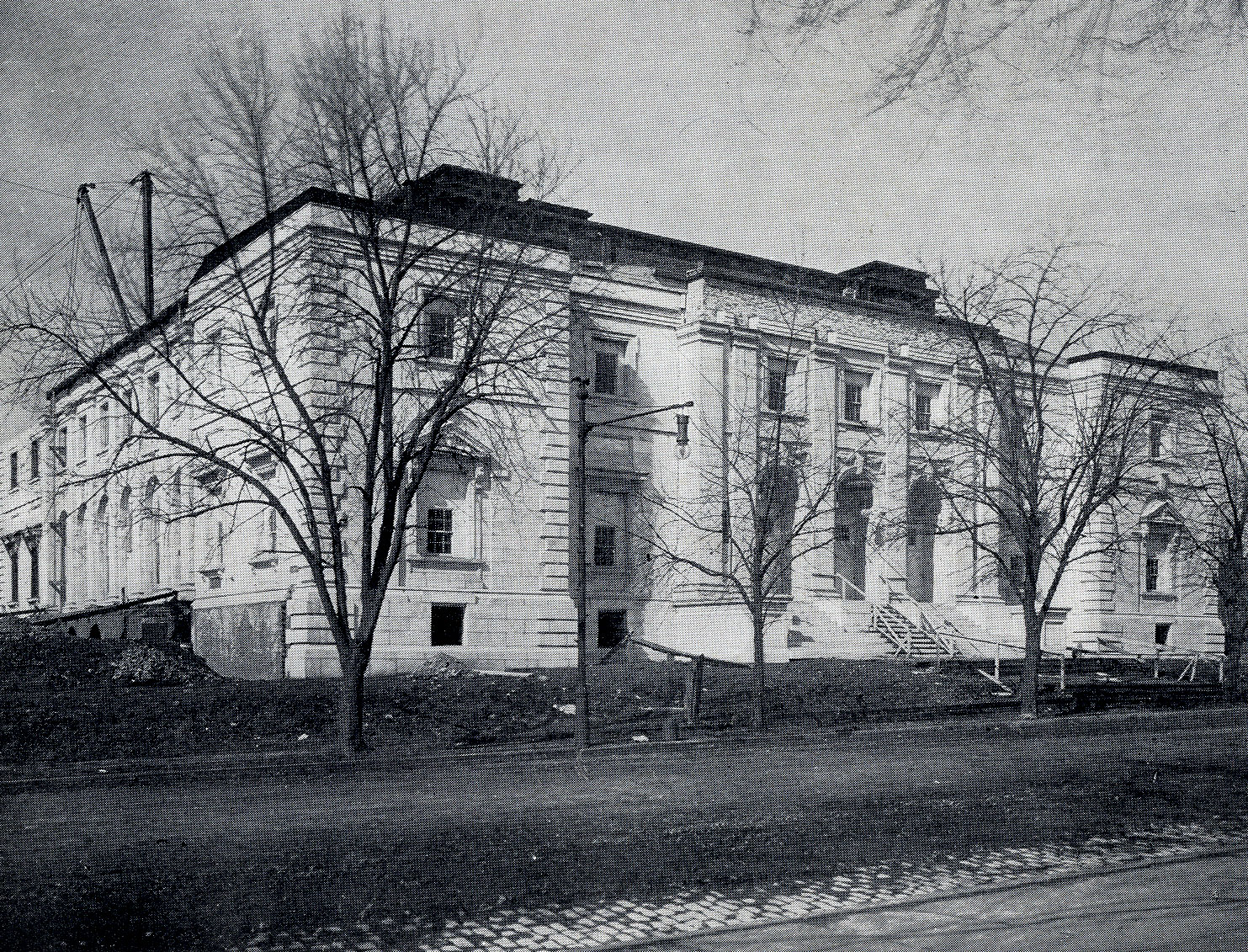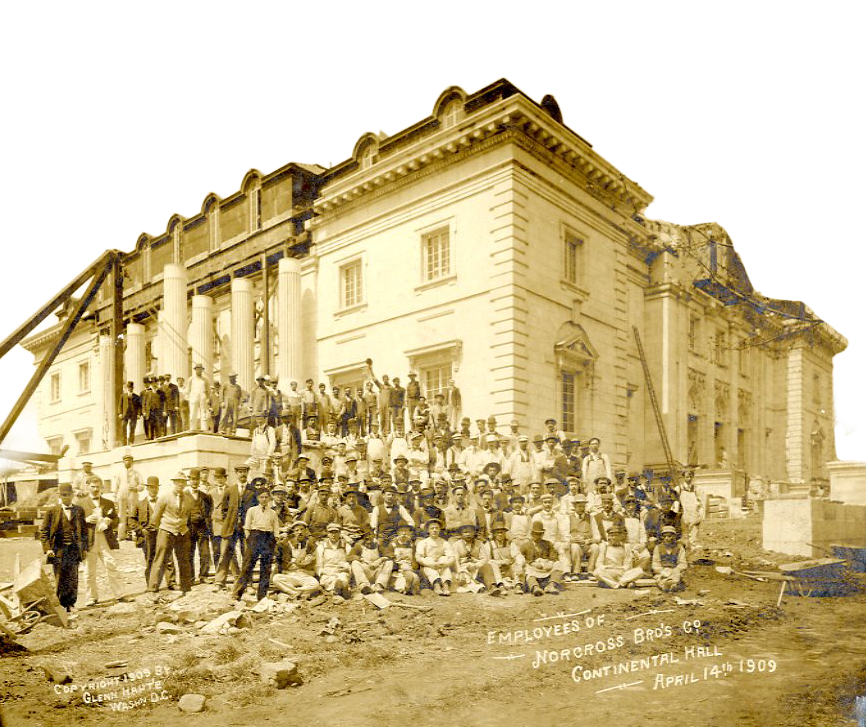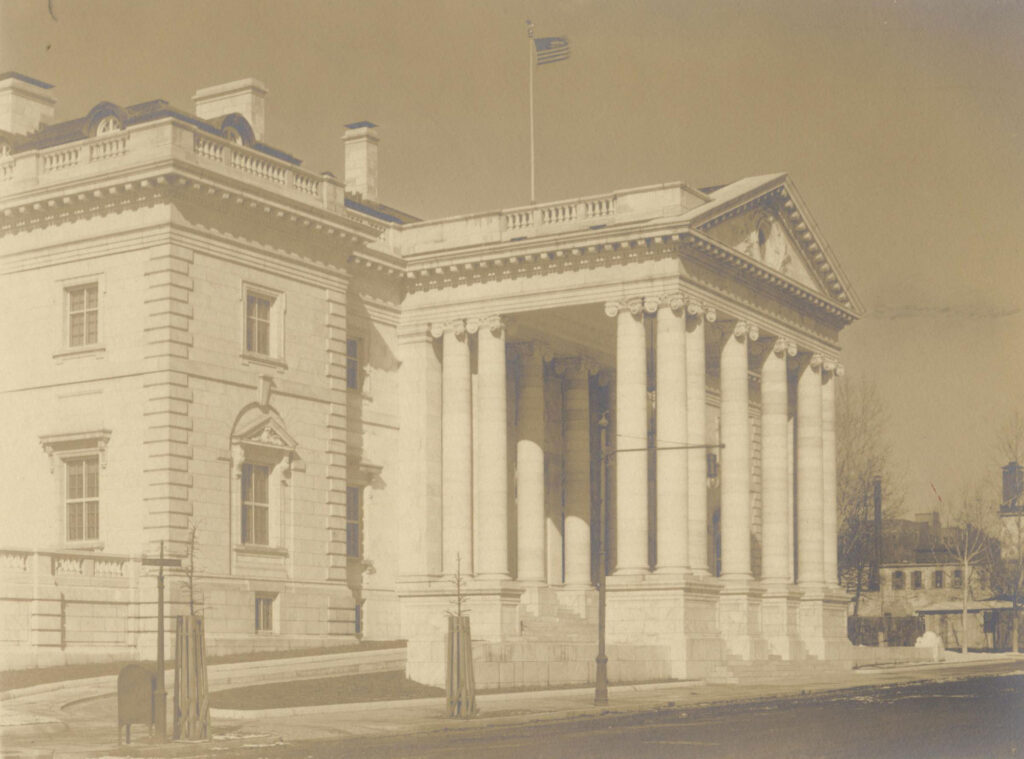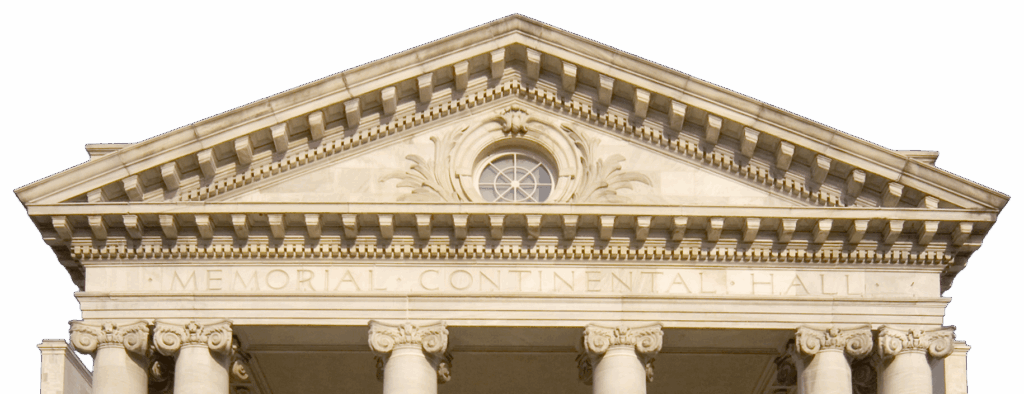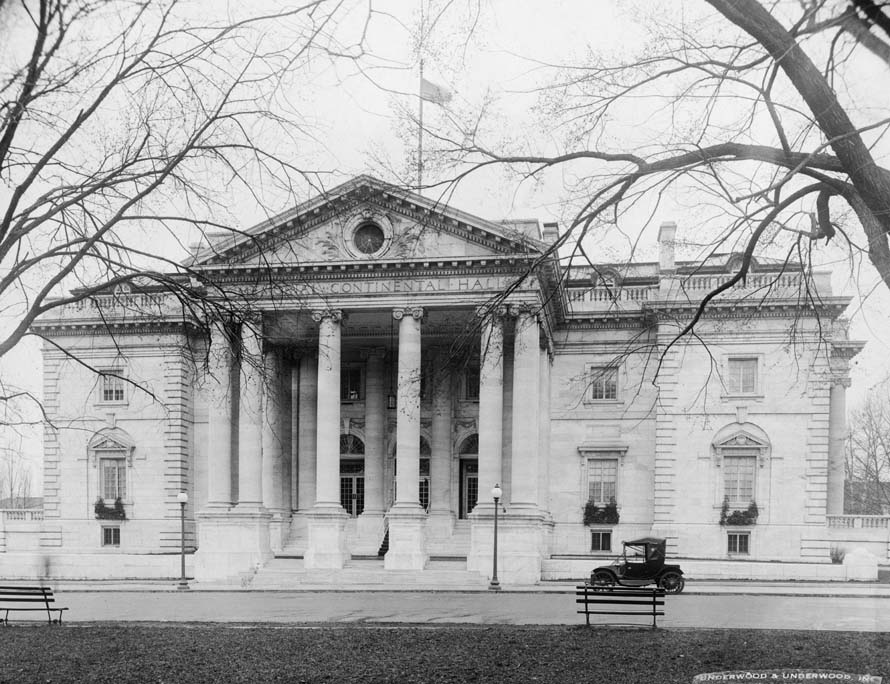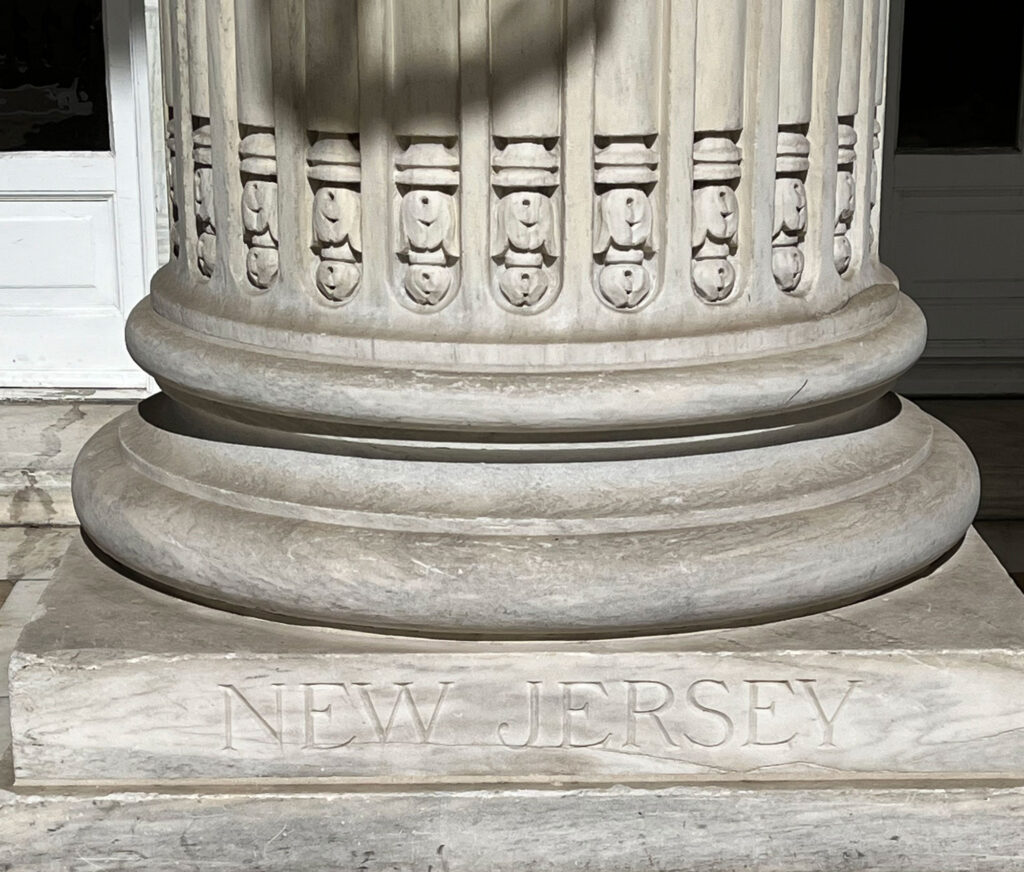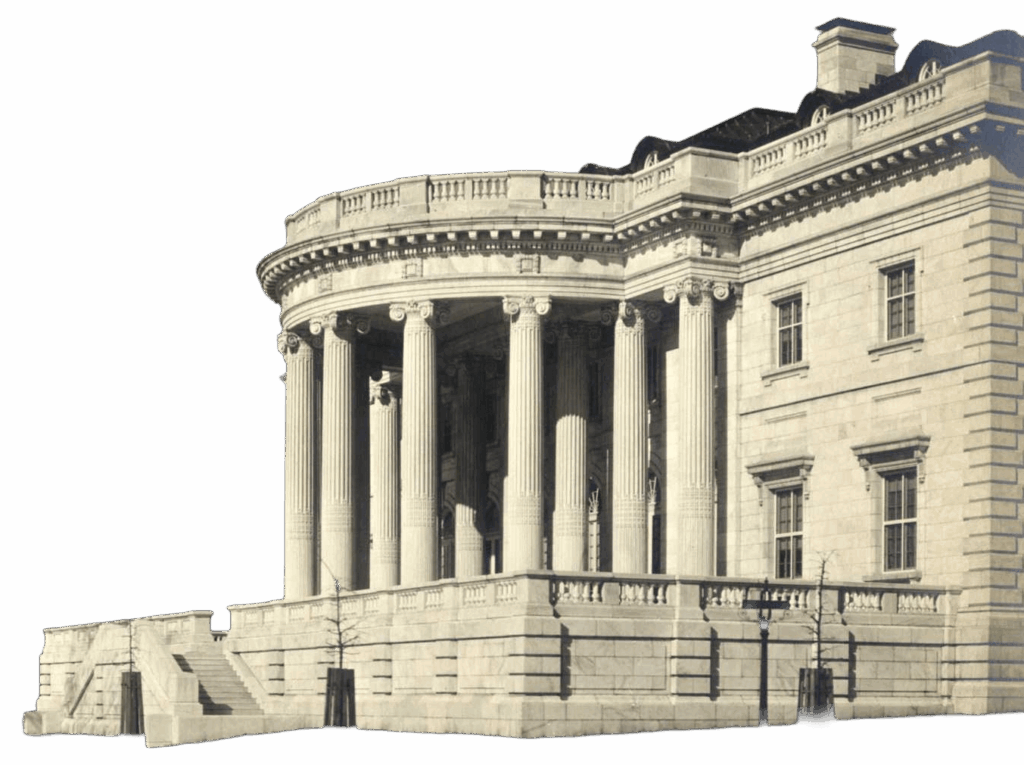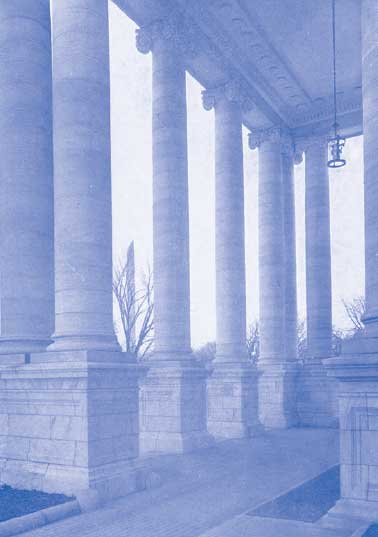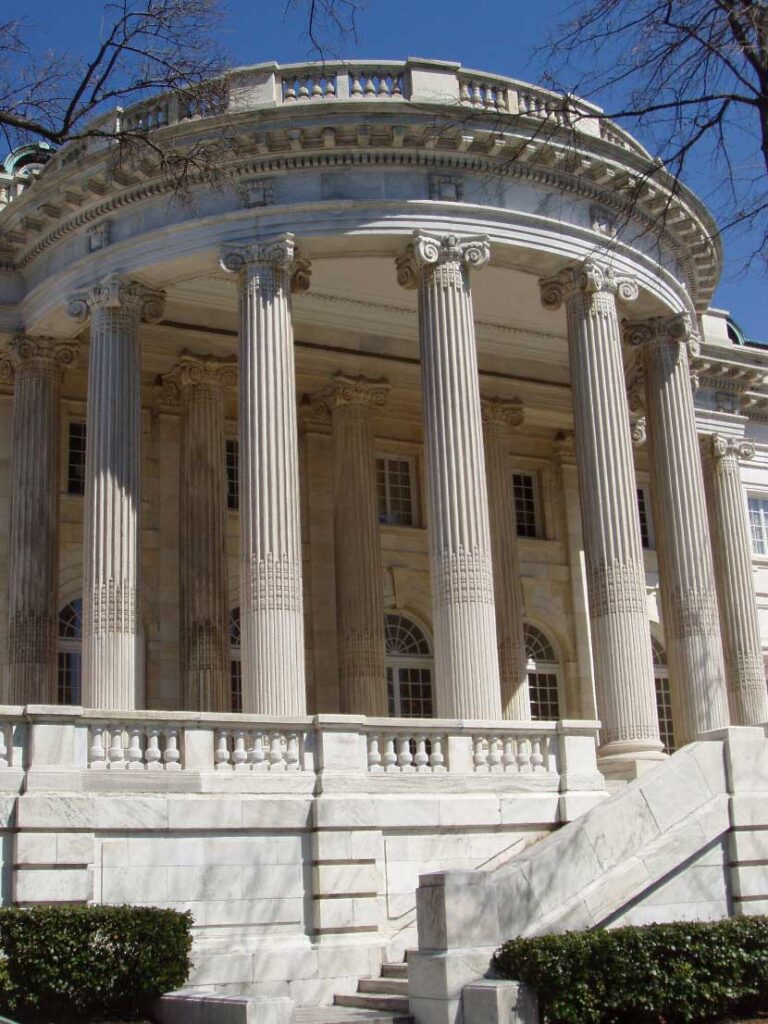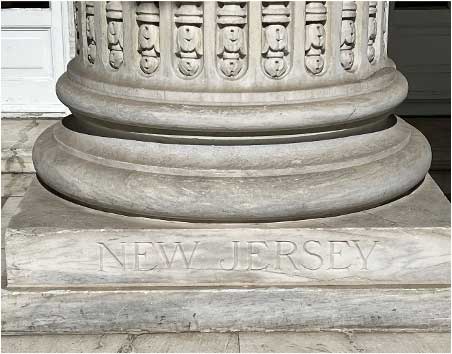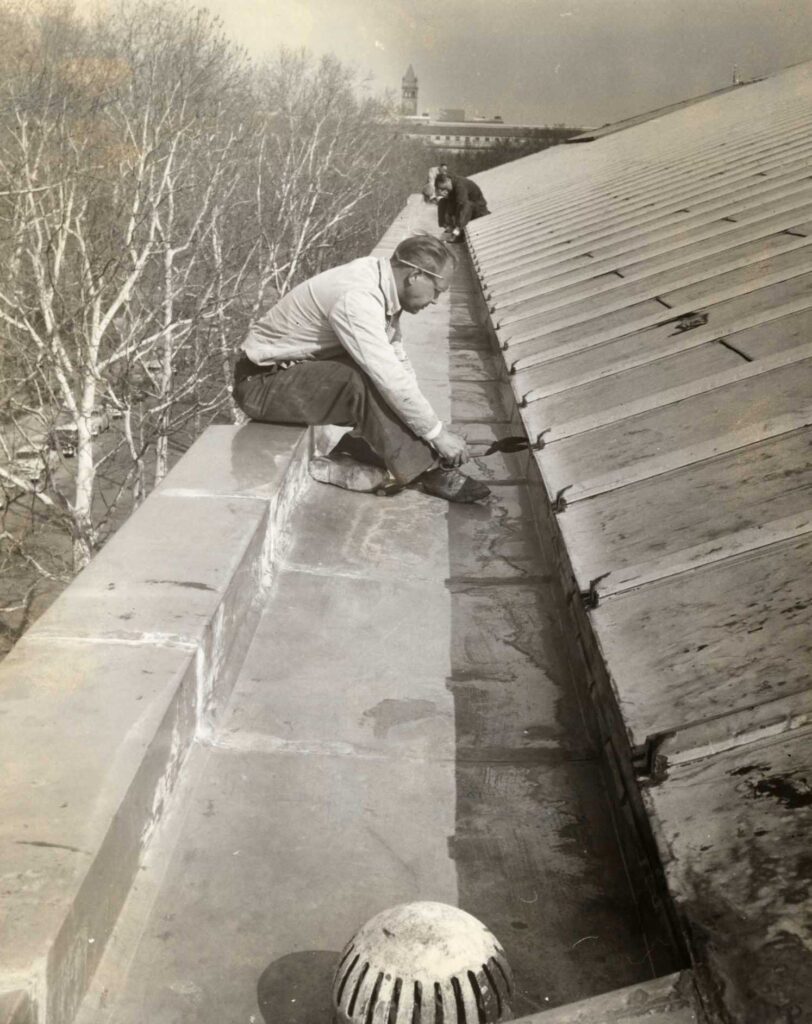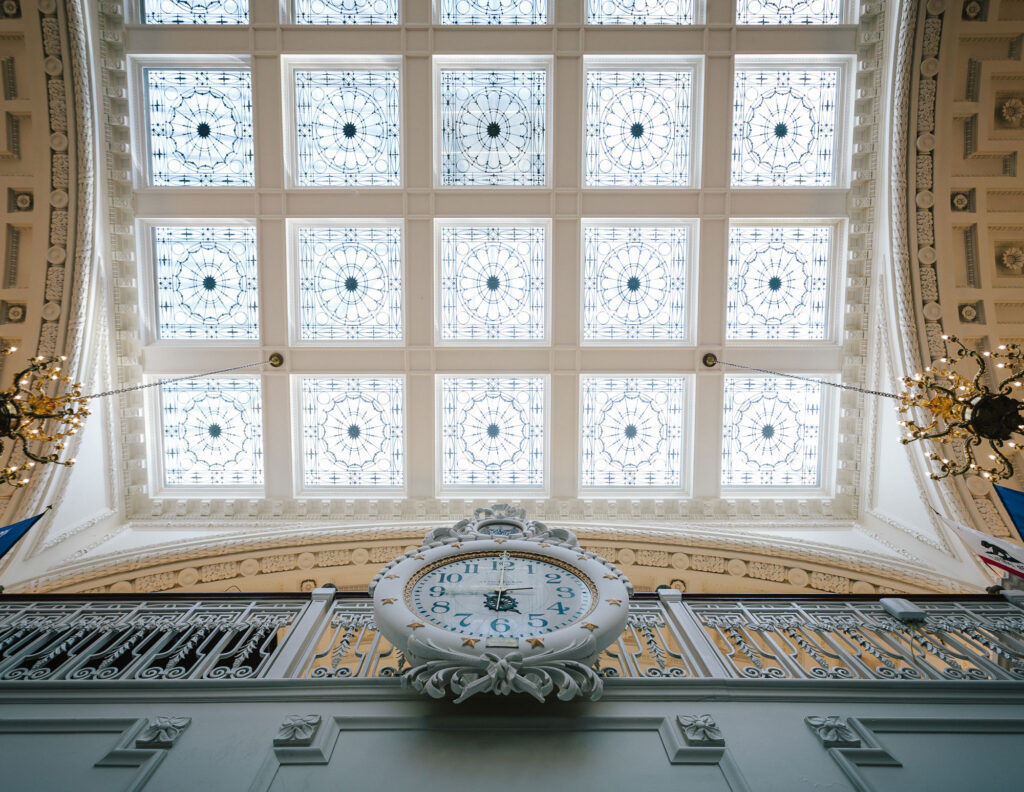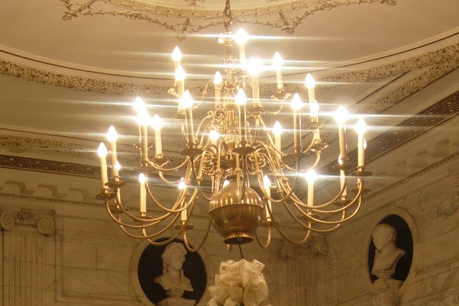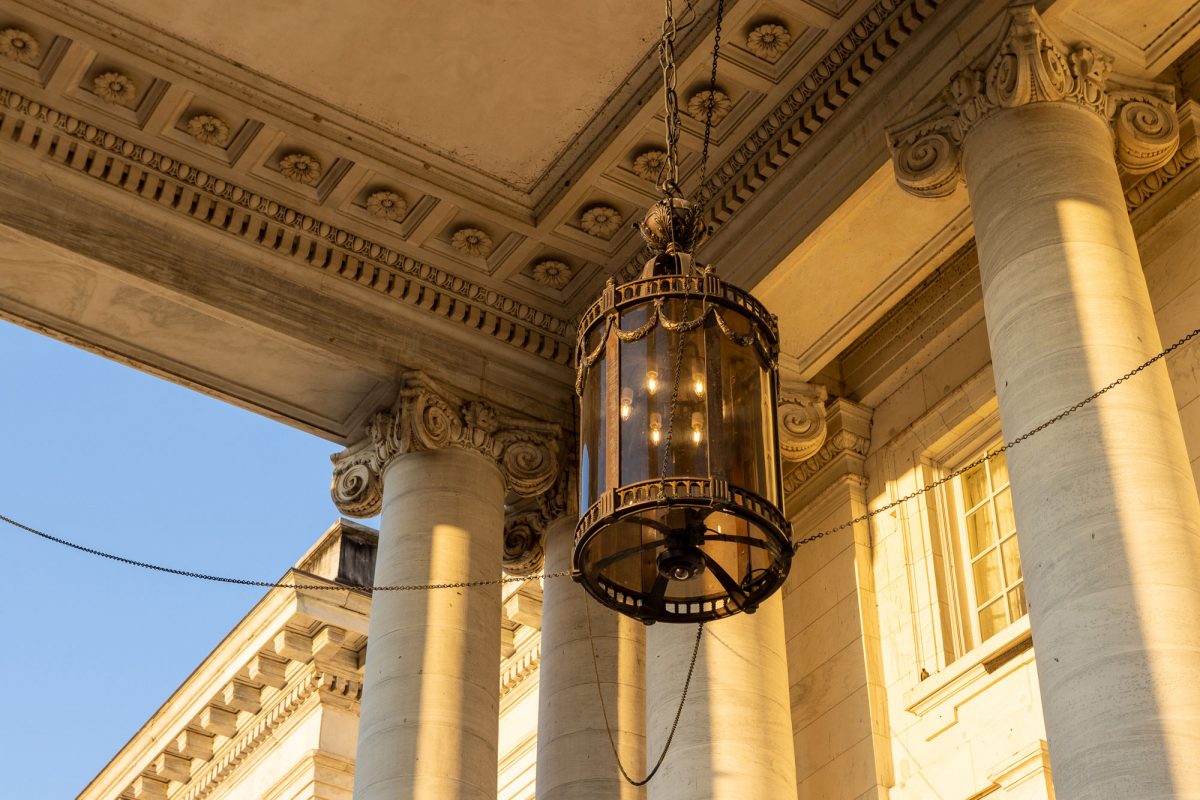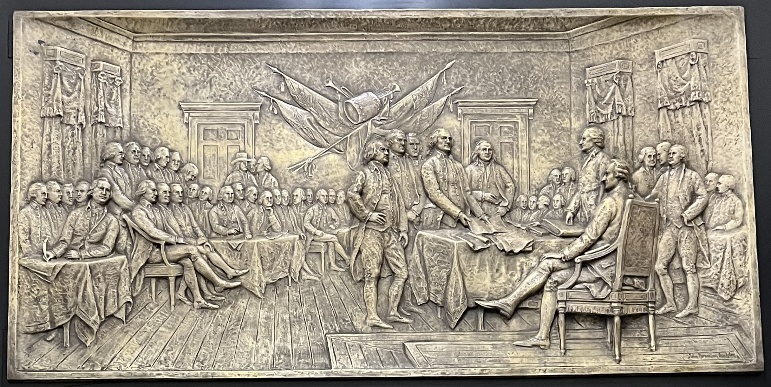Exterior & Decorative Ornamentation
Memorial Continental Hall was built at a cost of more than $500,000, and by April 1905, sufficient work had been accomplished on the central part of the building for the fourteenth Continental Congress to be held within this space.
Still only partially completed, birds found openings in the temporary canvas roof stretched across the auditorium, which sat approximately two thousand individuals. The birds’ excited twittering provided a musical background to the business sessions occurring below.
The building of the corner pavilions and porticos was then undertaken. On April 19, 1907, during the Sixteenth Continental Congress, the Memorial portico was dedicated.
By the Nineteenth Continental Congress, April 18 – 23, 1910, much of the handsome mahogany furniture promised by the States reserving memorial rooms was installed. Memorial Continental Hall was now the actual headquarters of the National Society.
Front Portico
The roof of the front portico is supported by sixteen immense drum columns. The Ann Story Chapter of Rutland, Vermont, sent $100 to have the inscription “Daughters of the American Revolution” carved across the front above the columns.
The roof of this portico is supported by sixteen immense drum columns.
This artwork served as the cover of “A Century of Service: The Story of the DAR.” The original painting, by P. Buckley Moss, was a gift of the Virginia Daughters during the organization’s Centennial celebration.

When Memorial Continental Hall was completed, the Washington Evening Star reported: “This Valhalla is unique. It is the costliest and most impressive monument of its kind ever built by women in this country or any other. Many other halls of fame have been erected and other grand monuments consecrated to the memory of some individual heroic figure in the history of our nation, but this is the first building dedicated to all the recognized heroes of the American Revolution: men and women alike. From the artistic standpoint it is one of the finest buildings which the beautiful capital contains, and from the utilitarian it is destined to become one of the most useful.”
Memorial Portico
Patriotism has been regarded by many as simply the willingness to lay down one’s life for the country. That is perhaps the narrowest view that can be taken of patriotism. Perhaps it is the most selfish view that can be taken of that noble virtue.
Patriotism in its broad and splendid spirit means the self-effacement of the individual for the greatest good of the greatest numbers, the willingness to self-sacrifice, to put down the things that are for selfish interests, in order that we may rise to a higher and finer civilization. It was this spirit that prompted the men who fought in the Revolution, not simply that they might be severed from the mother country, but that they might have greater liberty, and upon this continent might build a better, a freer and a nobler civilization.
Patriotism therefore manifests itself not simply in times of war, but in times of peace. The time will come when marble will ‘be erected to commemorate the battles that have been won in legislative halls, for laws that are better, that have for their object the uplifting of the nation. Time will come when we shall not only memorialize the heroes of war, but the judge upon the bench who has been honest and upright, the man in executive office who has been true to his trust, who has been true to the people and their best and highest interests.
Address Delivered by Charles Willis Needham, President of George Washington University, April 19, 1907, at the Dedication of the Memorial Portico.
Thirteen monolithic columns support the roof of the Memorial Portico on the south side of the building. The columns are named for the States in the order in which the thirteen original States entered the Union. These columns were all presented by the chapters or Legislatures of the thirteen original States. Many diplomatic and official government functions have been held in Memorial Continental Hall’s auditorium and the Memorial Portico entrance was used by the President of the United States when he attended.
As the façade was being clad in Vermont marble, Miss Mary Desha, Honorary Vice President General, expressed concern to the Architecture Committee that the marble for the monolithic columns of the Memorial Portico came from only one source. She suggested that instead marble should be brought from each of the original thirteen states. Miss Desha felt that treating the columns in this manner would enhance state pride in the new headquarters. Casey indicated in a reply that “the various white marbles of the country are of quite different color, texture and making [and]… after a few years weathering the difference becomes quite apparent and would be very detrimental to the appearance of the building.” Thankfully the architect won the day.

Memorial Portico
“Patriotism has been regarded by many as simply the willingness to lay down one’s life for the country. That is perhaps the narrowest view that can be taken of patriotism. Perhaps it is the most selfish view that can be taken of that noble virtue.
Patriotism in its broad and splendid spirit means the self-effacement of the individual for the greatest good of the greatest numbers, the willingness to self-sacrifice, to put down the things that are for selfish interests, in order that we may rise to a higher and finer civilization. It was this spirit that prompted the men who fought in the Revolution, not simply that they might be severed from the mother country, but that they might have greater liberty, and upon this continent might build a better, a freer and a nobler civilization.
Patriotism therefore manifests itself not simply in times of war, but in times of peace. The time will come when marble will ‘be erected to commemorate the battles that have been won in legislative halls, for laws that are better, that have for their object the uplifting of the nation. Time will come when we shall not only memorialize the heroes of war, but the judge upon the bench who has been honest and upright, the man in executive office who has been true to his trust, who has been true to the people and their best and highest interests.”
Address Delivered by Charles Willis Needham, President of George Washington University, April 19, 1907, at the Dedication of the Memorial Portico.
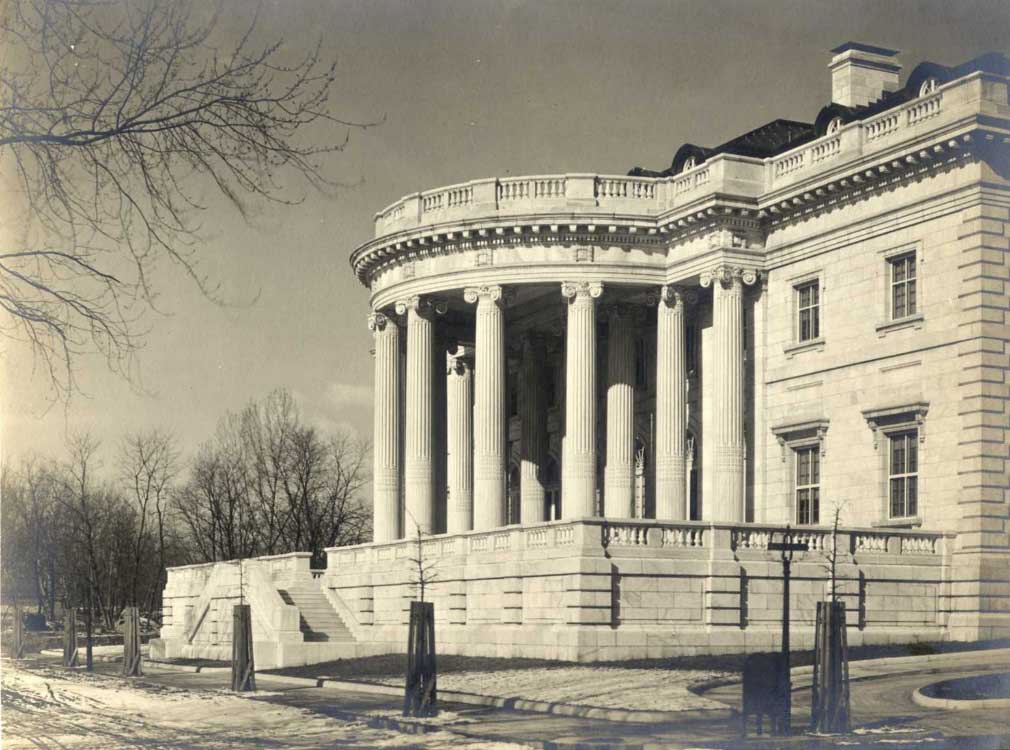
As the façade was being clad in Vermont marble, Miss Mary Desha, Honorary Vice President General, expressed concern to the Architecture Committee that the marble for the monolithic columns of the Memorial Portico came from only one source. She suggested that instead marble should be brought from each of the original thirteen states. Miss Desha felt that treating the columns in this manner would enhance state pride in the new headquarters. Casey indicated in a reply that “the various white marbles of the country are of quite different color, texture and making [and]… after a few years weathering the difference becomes quite apparent and would be very detrimental to the appearance of the building.” Thankfully the architect won the day.
Architect, Edward Pierce Casey envisioned a Hall in the then popular beaux-arts classical revival style. The beaux-arts (French for “fine arts”) drew its classically inspired motifs from a variety of sources including ancient Greece and Rome as well as from 18th century England, France, and colonial America. The Hall, both inside and out, is dripping with classical decoration synonymous with this style; the porches supported by stop-fluted Ionic columns, a detailed cornice complete with elaborate moldings and dentils, and a balustrade around the roof’s perimeter hiding a mansard roof. Because of its classical detailing, the Hall fit in well with the colonial revival, a movement that celebrated America’s colonial past.
Decorative Ornamentation
The beauty of the interior is highlighted with working fireplaces in each of the corner pavilion rooms (Indiana, Illinois, New York, and Ohio).
Rooms possess a fully developed classical cornice with carved and applied molded embellishments in the form of swags, garlands and sunbursts around the fireplaces.
Memorial Continental Hall incorporated the latest technological advancements of the time. The building was also lighted and powered by electricity and featured two elevators that went from the basement to the third floor.

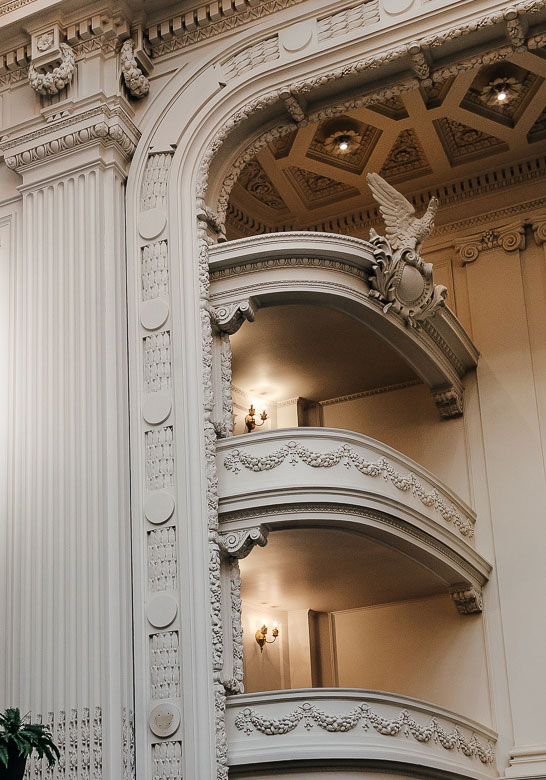
All the woodwork and walls of the corridors and rooms were painted glossy white in two coats called “White-China gloss.” The labor-intensive process entailed applying a lead paint and adding a glazed surface to simplify cleaning.
All wood floors were finished with linseed oil. And many of the public bathrooms were paneled with Tennessee marble and the stall partition doors were made of painted white pine.

The history of lighting fixtures spans from ancient times to the modern era, evolving from basic fire and oil lamps to the sophisticated electric lighting systems of today. Early civilizations used fire for warmth and light, transitioning to oil lamps, candles, and eventually gas lighting in the 19th century. The invention of the incandescent light bulb by Thomas Edison in the late 19th century marked a pivotal moment, leading to the widespread adoption of electric lighting.
Throughout Memorial Continental Hall many styles of fixtures have been used to illuminate the beautifully decorated interior and exterior. Fixture styles also varied depending on how light was delivered. Victorian lights took different forms in each country, designers adored the elaborate curves and nature-inspired patterns and agreed it was ornate, elegant, whimsical, and graceful. Design styles throughout the Hall include Neo-Rococo (1820-1870), Gothic, Mission Revival (1890-1915), and Les Arts Decoratif, later known as Art Deco style. This style included not only geometric, clean lines of Streamline Modern, but also floral designs derived from Art Nouveau.
The entire Decleration of Independence and relief was presented to the National Society by Alfred J. Brosseau, in honor of his wife, Grace Lincoln Hall Brosseau, President General, 1926-1929.
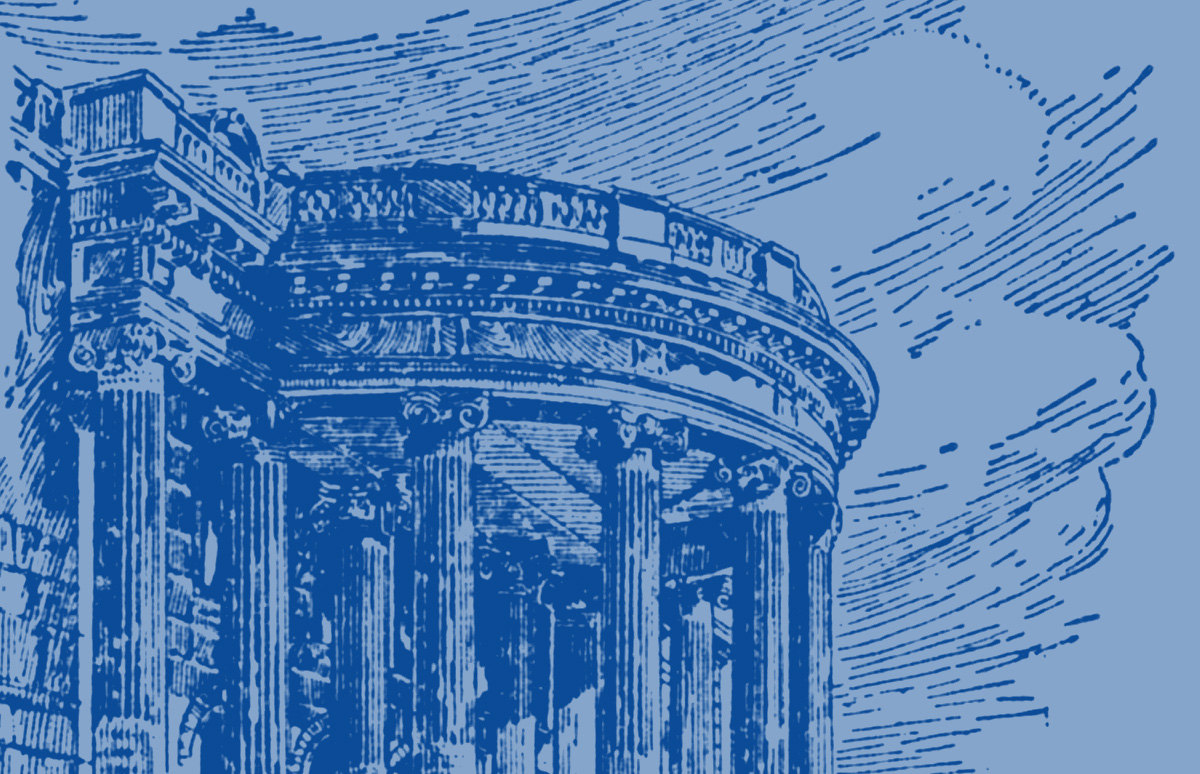
Video Series
A Closer Look at Memorial Continental Hall

Memorial Continental Hall contains a plethora of great artistic flair and technical ingenuity. They are interesting, very beautiful and drawl the viewer in while imagining the craftmanship of the time.


